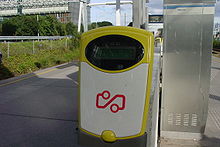National tariff system (Netherlands)
The national tariff system (NTS) of the Netherlands is a nationwide zone system for the use of local public transport . It is based on the Nationale vervoerbewijzen (tickets, NVB for short), introduced in May 1980, and especially the national stripe cards ( Strippenkaart ). The national system includes metro (underground), trams , urban and regional bus routes (exceptions are some express bus routes ) and trains on selected railway lines. In the vicinity of the large cities of Amsterdam , The Hague and Rotterdam , all regional means of transport can be used similar to a transport association.

For journeys on the Nederlandse Spoorwegen's rail traffic, you usually need your own train tickets (exception: OV-chipkaart ).
Sales and organization are taken over by Vervoerbewijzen Nederland BV (VBN).
Ticket types
- Weekly and monthly tickets ( ster subscription )
- Summer day tickets in June, July and August ( Zomerzwerfkaart )
- OV chip cards ( OV-chipkaart ) ("ov" from o penbaar v ervoer → public transport) for buses, trams, metro and railways for one-time use (single and day tickets) and as a chip card valid for several years in anonymous or personal form, which can be topped up with a credit for distance-dependent billing and with single, daily, weekly and monthly cards. The OV student card is also valid on all trains in 2nd class ( ICE International and Fyra with a surcharge, except Thalys).
- Stripe cards with 2, 3, 8, 15 or 45 stripes were available until November 2, 2011. Discounted from 15 strips. For each zone traveled through, the passenger had to purchase one lane plus one basic lane per trip. This system was replaced by the kilometer-specific billing of the OV chip card.
Validity in regional rail traffic
- Groningen - Roodeschool ( Arriva )
- Groningen - Delfzijl (Arriva)
- Groningen - Nieuweschans - Leer (East Frisia) (Arriva)
- Arnhem - Winterswijk ( Keolis Nederland )
- Zutphen - Winterswijk (Keolis Nederland)
- Zutphen - Oldenzaal (Keolis Nederland)
- Zutphen - Apeldoorn ( NS )
- Between all stations in the Amsterdam / Duivendrecht / Diemen area (except Schiphol )
- Between all stations in The Hague , Rijswijk and Voorburg
- Maastricht Randwyck - Maastricht - Heerlen - Kerkrade (between Heerlen and Kerkrade only on Veolia trains)
- Between all stations in Rotterdam , Capelle a / d IJssel , Schiedam and Vlaardingen
- Utrecht Overvecht - Utrecht Centraal - Utrecht Lunettes
Web links
- VBN tariff information , Dutch